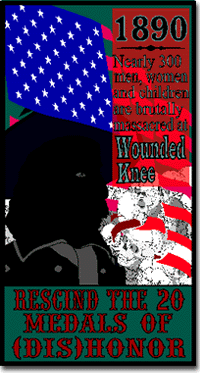40e. The Wounded Knee Massacre

Congressional Medals of Honor were awarded to many of the cavalrymen who fought at Wounded Knee. Despite the current view that the battle was a massacre of innocents, the Medals still stand. Some native American and other groups and individuals continue to lobby Congress to rescind these "Medals of dis-Honor."
The armed resistance was over. The remaining Sioux were forced into reservation life at gunpoint. Many Sioux sought spiritual guidance. Thus began a religious awakening among the tribes of North America.
Arrival of the "Ghost Dance"
Called the "Ghost Dance" by the white soldiers who observed the new practice, it spread rapidly across the continent. Instead of bringing the answer to their prayers, however, the "Ghost Dance" movement resulted in yet another human travesty.
It all began in 1888 with a Paiute holy man called Wovoka. During a total eclipse of the sun, Wovoka received a message from the Creator. Soon an Indian messiah would come and the world would be free of the white man. The Indians could return to their lands and the buffalo would once again roam the Great Plains.
Wovoka even knew that all this would happen in the spring of 1891. He and his followers meditated, had visions, chanted, and performed what became known as the Ghost Dance. Soon the movement began to spread. Before long, the Ghost Dance had adherents in tribes throughout the South and West.
Although Wovoka preached nonviolence, whites feared that the movement would spark a great Indian rebellion. Ghost Dance followers seemed more defiant than other Native Americans, and the rituals seemed to work its participants into a frenzy. All this was disconcerting to the soldiers and settlers throughout the South and West. Tragedy struck when the Ghost Dance movement reached the Lakota Sioux.
Local residents of South Dakota demanded that the Sioux end the ritual of the Ghost Dance. When they were ignored, the United States Army was called for assistance. Fearing aggression, a group of 300 Sioux did leave the reservation. Army regulars believed them to be a hostile force preparing for attack. When the two sides came into contact, the Sioux reluctantly agreed to be tranported to Wounded Knee Creek on Pine Ridge Reservation.
A Final Tragedy
On the morning of December 29, 1890, the army demanded the surrender of all Sioux weapons. Amid the tension, a shot rang out, possibly from a deaf brave who misunderstood his chief's orders to surrender.
The Seventh Cavalry — the reconstructed regiment lost by George Armstrong Custer — opened fire on the Sioux. The local chief, Big Foot, was shot in cold blood as he recuperated from pneumonia in his tent. Others were cut down as they tried to run away. When the smoke cleared almost all of the 300 men, women, and children were dead. Some died instantly, others froze to death in the snow.
This massacre marked the last showdown between Native Americans and the United States Army. It was nearly 400 years after Christopher Columbus first contacted the first Americans. The 1890 United States census declared the frontier officially closed.






